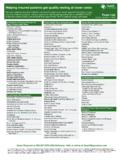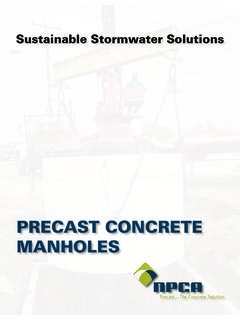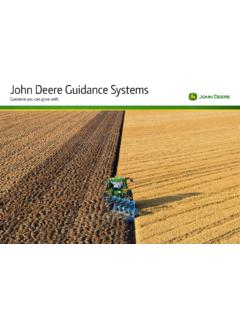Transcription of Do It Yourself Switch Machines - housatonicrr.com
1 Do It Yourself Switch Machines And save a ton of dough! Presented by Craig Bisgeier Malvern PA RPM 2008. What does a Switch machine do? Move Switch points back and forth Hold points in position Allow operator to change position Switch frog electrical polarity Work reliably Commercial Options - Pros Commercial Options - Pros Pre-engineered, off-the-shelf solution readily available Install instructions Shared experience of others No need to re-invent the wheel Commercial Options - Cons Often expensive per unit Limited selection of offerings Off-the-shelf may not meet your needs Why make your own? To save money! Gain control over design, options Build to meet your needs Great learning experience It's fun!
2 Not covered here: Electrical / Electronic solutions Not within reach of most modelers High quality, safe options already available Ask after clinic about coming options :). What is covered here: Trackside Switch Machines Under-table Switch Machines What parts make up a machine How they work together Design a machine by selected criteria Control options (Manual). Caboose Ground Throws Effective option at reasonable price Reliable, easy to install Power switching models much more expensive Look really bad in photos Photo by Roger P. Hensley Simplest option - Nails and wire Simply two nails driven into layout next to points Wire 'hook' that connects to throw bar Hook goes on either side of nails to hold points Wire may be guided by staples Simplest option - Nails and wire Looks pretty bad but really cheap Could power frog if wires hooked up to hook and nails Very low-tech but it works!
3 Finger spring Action similar to Peco and Micro-Engineering turnouts Stiff wire in "J" shape Installs in hole in roadbed, throw bar Compression on spring wire holds points ot stock rails Spring compresses when moved across centerline Finger spring Tricky to install, wear reduces effectiveness Difficult to adjust Bend in spring helps but looks really bad Also really cheap, easy to build Slide Switch Switchstand First I know of in Australia, 1995. Tony Koester using this on NKP third sub Small slide Switch installs next to points small wire pushrod hooked up from throwbar to Switch slider throwbar moves with slide Switch Slide Switch Switchstand Switch slider disguised by scale switchstand glued to top Frog power controlled by slide Switch Moderately difficult install, tough to adjust after install Looks really good, operates pretty well Under Table Options All designed using most of these features: LEVERS.
4 2nd-class lever, 1 or more (like a seesaw, fulcrum at or near center, work applied to ends). Allows for small hole in benchwork beneath points Under Table Options Tortoise, Blue Point Machines use 2nd class levers Useful because fulcrum location helps keep hole in roadbed small Changing location of fulcrum changes force to distance inversely Springs - Compression Compression spring like Mousetrap, Clothespin Force things together or apart Old twin-coil electric Machines used compression spring to hold points after throw "Over-Center" type of spring, like finger throw we saw before Great for holding points to stock rails Easy to make Yourself , inexpensive, reliable Springs - Tension Tension springs like bedframe springs.
5 Rubber bands Can be used in many ways for turnout control Works with a variety of control methods String or cable tied to motion arm, pulled on by knob or lever Springs Can be used in non-linear solutions Or used against a pushrod to force return against unconnected device Tension and compression springs can often be used in similar situations You decide which works better for given application FULCRUM. Adjustable fulcrum helps set good tension on points, throw distance Tortoise and Blue Point offer this option Fixed fulcrums work OK, best to discover "Sweet spot" thru experimentation before committing to design Electrical Switch Often need method to Switch frog polarity with points must be SPDT or DPDT.
6 Two methods - home-built or commercial Home built - any method to transfer power on change of position wipers, wires - Hump Yard Purveyance had good idea throw pin wired to frog, wires located to either side powered from bus Electrical Switch Commercial switches - many good options, some not so good Slide Switches - seem like good idea but can be limiting Can restrict movement of motion arm if not carefully designed Detents seem like good idea, but incomplete throwing may cause dead frog Electrical Switch Lever switches - Mount independent of motion arm but contact it to throw Can mount many places, use in different ways - Side, end, anywhere able to contact moving parts also problematic installation sometimes Can be rotated for fine adjustment after install Frog always powered, no dead position PUSHRODS.
7 Connect Switch machine to controlling device Make from sturdy wooden dowels or wire When possible include Z. bend to cushion force Support long rods to prevent sagging, bending CONTROLS. Usually fascia-mount - knobs, handles Fancy or simple, attach with threads, epoxy, etc. Some unusual options - Barrel bolts, armstrong levers How to design a Switch machine Criteria for selecting a design: On table / Under table Clearance Frog Power Actuation Construction and Materials Mounting Versatility Form follows function - answers to these questions help determine design 1st criteria - Below table Above table designs more obvious, fewer choices Select basic design of base and 2nd class lever motion arm 2nd criteria - Clearance issues No clearance issues This design not affected by sight lines, cramped bencheork Goal is always to design as small as possible.
8 But without issues more vertical design options are open 3rd Criteria - Frog Power Design will have to support powering turnout frog electrically commercial or home- made Switch to be integrated 4th Criteria - Actuation Push-pull operation selected Will require spring to hold points in place to either side Over-Center compression spring is great choice Include method to connect pushrod to motion arm 5th Criteria - Construction and materials Wood and Wire selected Metal and Plastic also good options Most modelers more familiar with woodworking Have basic tools and materials (saws, glue) for working wood 6th Criteria - Mounting Depends on (sub). roadbed materials Include mounting flange with screw hole 7th Criteria - Versatility Can machine be made to work in more than one way?
9 Use push-pull or return spring actuation? Be mounted vertically or horizontally? Support different methods of powering frog? Allow adjustment before or after install? Selected Properties Under-table with no clearance issues Motion arm / throwing pin is 2nd class lever Push-pull operation Switch to power frog Made from wood and wire components Mounts vertically to (sub)roadbed Base Mounting flange has to go on back, or it interferes with arm Single mounting point makes installation, adjustment easier Fulcrum for motion arm must be adjustable make fulcrum from small wire loop drill several holes in base near top to facilitate adjustment of fulcrum Levers Blue Point and Tortoise actually use two levers - actual throwing pin and shorter motion arm inside Motion arm will have fulcrum at high end connection for throwing pin near lower end Levers Connection for pushrod at lower end and connection point for O- C spring near center Throwing pin will attach in hole with capture screw.
10 Like Tortoise Thread throw pin thru fulcrum loop Design Process Problem - throwing arm mounts too high on base, needs to be recessed Redesign base to allow motion arm to be recessed into it Base can be built up from straight parts or milled with woodworking tools Design Process Recess give us a place to mount Switch (lever) on one side, contacting motion arm - spring will ensure good contact Switch can be mounted either side, versatility plus Design Process O-C spring mounts near bottom edge of base (centered). and on motion arm near end (centered). Farther mounted from fulcrum provides more spring travel, force Make several loops in spring, more even force for travel distance Design Complete!





